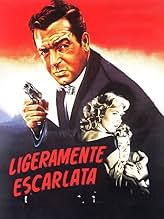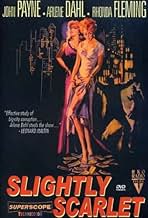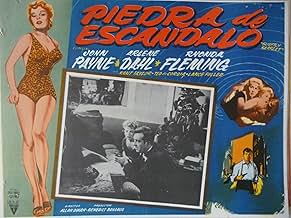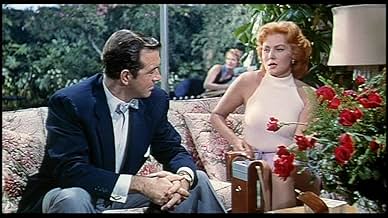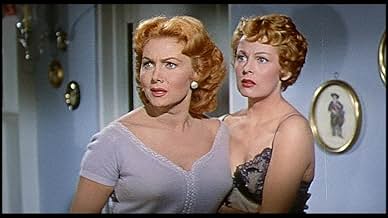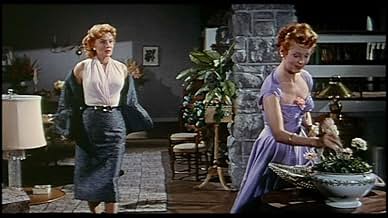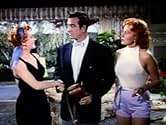VALUTAZIONE IMDb
6,5/10
1375
LA TUA VALUTAZIONE
Un venditore ambulante s'innamora della fidanzata del neoeletto sindaco della città e resta coinvolto in un giro di criminalità organizzata, mazzette e politici corrotti.Un venditore ambulante s'innamora della fidanzata del neoeletto sindaco della città e resta coinvolto in un giro di criminalità organizzata, mazzette e politici corrotti.Un venditore ambulante s'innamora della fidanzata del neoeletto sindaco della città e resta coinvolto in un giro di criminalità organizzata, mazzette e politici corrotti.
Fred Aldrich
- Policeman
- (non citato nei titoli originali)
Murray Alper
- Hood
- (non citato nei titoli originali)
Albert Cavens
- Man at Campaign Headquarters
- (non citato nei titoli originali)
Ellen Corby
- Martha
- (non citato nei titoli originali)
Paul Cristo
- Man at Campaign Headquarters
- (non citato nei titoli originali)
Sam Flint
- Man at Campaign Headquarters
- (non citato nei titoli originali)
Curt Furberg
- Man at Campaign Headquarters
- (non citato nei titoli originali)
Rudy Germane
- Hood
- (non citato nei titoli originali)
Frank Gerstle
- Dave Dietz
- (non citato nei titoli originali)
Kenneth Gibson
- Man at Campaign Headquarters
- (non citato nei titoli originali)
Roy Gordon
- General Norman B. Marlowe
- (non citato nei titoli originali)
Recensioni in evidenza
First, let's be straight: this is a deliriously entertaining, venal and vampy exercise in melodrama. It's a ridiculous movie with a nonsensical script, awesome crazy quilt radioactive light bright technicolor and at times laughably non-motivated behavior. But it's also a tongue-in-cheek anti-noir mini masterpiece crammed with over dramatized scene chewing and pleasingly unintentional laughs. The set designs feature some of the biggest house interiors ever (how does Rhonda Fleming afford that mansion on her secretarial salary??) Arlene Dahl is a deliciously cheesy home run as the sex object du jour and gives Martha "The Big Sleep" Vickers a run for her money in the slutty and criminally irredeemable little sister department. Everyone is working some angle here (particularly John Payne), which is both intriguing and finally just dizzying. Fleming, Dahl, Payne and Kent Taylor take a love triangle and turn it into a quadralateral with little trouble. This isn't the calculated and sleek Double Indemnity James M. Cain, but it sure has the smoulder and desperation of The Postman Always Ring Twice JMC.
There's a political campaign thrown in and a big gangster (huffy and puffy Ted De Corsia) subplot for good measure, but this is ultimately a celebration of the campiest aspects of melodrama and what a party they throw! Definitely a date movie and highly entertaining for all the right reasons. If you can see it in the theatre, you may go blind from the glowingly phosphorescent crimson hues. "Slightly" Scarlet my ass!
There's a political campaign thrown in and a big gangster (huffy and puffy Ted De Corsia) subplot for good measure, but this is ultimately a celebration of the campiest aspects of melodrama and what a party they throw! Definitely a date movie and highly entertaining for all the right reasons. If you can see it in the theatre, you may go blind from the glowingly phosphorescent crimson hues. "Slightly" Scarlet my ass!
The 1956 film "Slightly Scarlet" at first glance looking back from our sophisticated perspective today seems to be a bit of a tongue-in cheek joke.
Directed by Allan Dwan from a Robert Blees screenplay adapted from James M. Cain's novel "Love's Lovely Counterfeit", the 99-minute film is a great combination of color and art direction in a film noir.
Not a highly regarded film noir, in Technicolor and Superscope its palette utilizes a wide range of color to support the individual themes and characterizations.
Our main characters have color scheme that establish them and develop with the story.
Arlene Dahl as Dorothy wears black as she is released from prison and even sports a black bathing suit later in the film.
Rhonda Flemming as June initially appears in Spring-like colors of off-white and yellow, with colors matching her mood as the film progresses. She wears white and blues when she meets Ben Grace for the first time, then black and off-white when they kiss and she begins to fall in love with him. When Dorothy is arrested Rhonda wears a grey sweater and skirt but by the end of the film June wears the same black color as Dorothy emphasizing her relationship to her bad sister.
Although the pivotal action of the film rests on Ben Grace, it is through June that we understand the important elements of the story, and the value of good and bad in this noir world as well as our own.
A study in duality, it falls short by not delivering what it promises but only shifts the pivotal actions onto the male character in the film.
In more than one scene characters tell Ben Grace that he is taking advantage of the situations around him to unfair terms.
Police man Dietz (Frank Gerstle), who Grace gets put into a high-ranking position accuses Ben of playing both ends toward the middle.
A great line from Sole Caspar to Ben Grace sums up his character completely: "Genius you're just a chiseler out for a soft spot. You're not crooked and you're not straight. You take what you can get where you can get it but you don't want any trouble. You'll die at age 66 with three grand in the bank but you'll never be an operator." Looking back its moments of plot change create humor because of the style of acting and the overall writing in the script.
But there is still ample example of real noir elements despite the color of the film.
The title suggests the slightly scarlet is a pun on the pure heart of the lead female as measured against the overall 'sick' nature of her sister, the one who steals.
The quality of the motivation to steal of the second female lead as compared against the organized mob activities of the lead crook is an interesting one. There is the opportunity foe the woman to become the girlfriend of the mob boss, and she seems perfectly matched for the role.
Directed by Allan Dwan from a Robert Blees screenplay adapted from James M. Cain's novel "Love's Lovely Counterfeit", the 99-minute film is a great combination of color and art direction in a film noir.
Not a highly regarded film noir, in Technicolor and Superscope its palette utilizes a wide range of color to support the individual themes and characterizations.
Our main characters have color scheme that establish them and develop with the story.
Arlene Dahl as Dorothy wears black as she is released from prison and even sports a black bathing suit later in the film.
Rhonda Flemming as June initially appears in Spring-like colors of off-white and yellow, with colors matching her mood as the film progresses. She wears white and blues when she meets Ben Grace for the first time, then black and off-white when they kiss and she begins to fall in love with him. When Dorothy is arrested Rhonda wears a grey sweater and skirt but by the end of the film June wears the same black color as Dorothy emphasizing her relationship to her bad sister.
Although the pivotal action of the film rests on Ben Grace, it is through June that we understand the important elements of the story, and the value of good and bad in this noir world as well as our own.
A study in duality, it falls short by not delivering what it promises but only shifts the pivotal actions onto the male character in the film.
In more than one scene characters tell Ben Grace that he is taking advantage of the situations around him to unfair terms.
Police man Dietz (Frank Gerstle), who Grace gets put into a high-ranking position accuses Ben of playing both ends toward the middle.
A great line from Sole Caspar to Ben Grace sums up his character completely: "Genius you're just a chiseler out for a soft spot. You're not crooked and you're not straight. You take what you can get where you can get it but you don't want any trouble. You'll die at age 66 with three grand in the bank but you'll never be an operator." Looking back its moments of plot change create humor because of the style of acting and the overall writing in the script.
But there is still ample example of real noir elements despite the color of the film.
The title suggests the slightly scarlet is a pun on the pure heart of the lead female as measured against the overall 'sick' nature of her sister, the one who steals.
The quality of the motivation to steal of the second female lead as compared against the organized mob activities of the lead crook is an interesting one. There is the opportunity foe the woman to become the girlfriend of the mob boss, and she seems perfectly matched for the role.
This movie showed Rhonda Fleming in a subdued part as a secretary to a town politico. She's one of my favorite actresses from the 50's, and was one of the most beautiful ever to grace the screen. John Payne was lucky enough to have a couple romantic scenes with her.
Back in the 50's, kissing scenes were far more romantic and tantalizing than today. Wish I could have bottled Rhonda Fleming!
Back in the 50's, kissing scenes were far more romantic and tantalizing than today. Wish I could have bottled Rhonda Fleming!
Big-city chronicle dealing with mobsters , corruption , prohibited loves and many other things . Concerning a small-time gangster carries out an assignment from Mafia boss , Ted de Corsia, to smear a law-and-order político , Ken Taylor , running for Mayor . Then he falls in love with the candidate 's secretary , Rhonda Fleming , it leads the plot mucks up even further . Innocent Rhonda has a crook , tipsy and ex-con sister , Arlene Dahl . Later on , Payne attempts to go straight and ends up running the dark business when De Corsia escapes town. Gang leader Payne meeting his comeuppance when he tangles with Rhonda's sister , Arlene Dahl , a hazardous Kleptomaniac . Out of the shadows of a vice-ridden city comes James M Caín most explosive drama ¡ James M Caín scorchingly frank expose of the operators behind big city graft.
A spiffy , thrilling and medium budget Noir Film drama based on the James M Caín novel titled "Love's lovely counterfeit" .James M Cain wrote the prestigious "The postman always rings twice" that had several cinematic adaptations and "Slightly scarlet" script was well written by Robert Blees . Being an effective and provoking studio about mafia , corruption , political messes and thunderous love relationships . This is a smart example of Allan Dwan's 50 output , a good and fine director who made a lot of films , many of them belonging to Noir genre . Although the story results to be some confusing , as forget the twisted plot and just watch the character actors and actresses interplay .Trío protagonists give nice acting . John Payne is frankly well as a gang leader tangled with two beautiful women. Rhonda Fleming is gorgeous as the good girl falling for gang leader and his sister Arlene Dahl is wonderful . Both of whom , Fleming and Dahl , steal the show as the two dynamic sisters . Support cast is very good such as : Kent Taylor , Ted de Corsia , Buddy Baer , Lance Fuller , Ellen Corby and many others .
Colorful cinematography in Technicolor and SuperScope by John Alton , a magnificent cameraman who along with Nicolas Musuruca are the main creators in Noir photography .As well as atmospheric and evocative cinematography by Louis Forbes and uncredited Howard Jackson . The motion picture produced by Benedict Bogeaus was competently directed by Allan Dawn . Even Martin Scorsese incidentally has tipped his cap to this great filmmaker and acknowledge him as an important influence . Dwan had a prolific career directing all kinds of genres as Westerns , Noir , drama , thriller , adventure, such as : Three musketeers , Iron mask , Pearl of the South Pacific , Heidi , Enchanted Island , Escape to Burma , The Gorilla , Rebecca of Sunnybrook farm , Passion , Brewster's millions , Cattle Queen Montana , Tenesse partner , Sands of Iwo Jima , among others . Rating 7/10 . Notable and decent Noir movie .
A spiffy , thrilling and medium budget Noir Film drama based on the James M Caín novel titled "Love's lovely counterfeit" .James M Cain wrote the prestigious "The postman always rings twice" that had several cinematic adaptations and "Slightly scarlet" script was well written by Robert Blees . Being an effective and provoking studio about mafia , corruption , political messes and thunderous love relationships . This is a smart example of Allan Dwan's 50 output , a good and fine director who made a lot of films , many of them belonging to Noir genre . Although the story results to be some confusing , as forget the twisted plot and just watch the character actors and actresses interplay .Trío protagonists give nice acting . John Payne is frankly well as a gang leader tangled with two beautiful women. Rhonda Fleming is gorgeous as the good girl falling for gang leader and his sister Arlene Dahl is wonderful . Both of whom , Fleming and Dahl , steal the show as the two dynamic sisters . Support cast is very good such as : Kent Taylor , Ted de Corsia , Buddy Baer , Lance Fuller , Ellen Corby and many others .
Colorful cinematography in Technicolor and SuperScope by John Alton , a magnificent cameraman who along with Nicolas Musuruca are the main creators in Noir photography .As well as atmospheric and evocative cinematography by Louis Forbes and uncredited Howard Jackson . The motion picture produced by Benedict Bogeaus was competently directed by Allan Dawn . Even Martin Scorsese incidentally has tipped his cap to this great filmmaker and acknowledge him as an important influence . Dwan had a prolific career directing all kinds of genres as Westerns , Noir , drama , thriller , adventure, such as : Three musketeers , Iron mask , Pearl of the South Pacific , Heidi , Enchanted Island , Escape to Burma , The Gorilla , Rebecca of Sunnybrook farm , Passion , Brewster's millions , Cattle Queen Montana , Tenesse partner , Sands of Iwo Jima , among others . Rating 7/10 . Notable and decent Noir movie .
Anyone remotely interested in cinematography and art direction should see this. John Alton, chiefly famous for his work in black and white, here switches to livid colour and achieves some of the most daring and moody effects ever known in colour films. This was a decade before 'flashing' the film became popular (a technique developed by Freddie Young, who told me all about it at the time he began the trend, with Lumet's 'Deadly Affair'). Everything here is so vivid, and the games played with colour in choice of sofas, walls, carpets, not to mention hair, are so intense, that the film is really chiefly of interest for all of that. Alton had to work only with variations in lighting, not with film processing possibilities. What he did is incredibly audacious, worth watching over and over just to study it. He has whole figures in shadow, and faces often are eclipsed by darkness in a bright room. It is really an incredibly dazzling display of virtuosity and genius. The two lead gals have matching hair, which plays well on the sets. Rhonda Fleming was a notorious strawberry blonde, and although I seem to recall that Arlene Dahl was really a normal blonde and presumably had her hair died to match Fleming's for this film, here they are very like the sisters they play indeed, with matching peachy hair and bright blue eyes. It is all a symphony of light and dark and colour combinations, like a modernist painting. The story is tepid, diluted from a James Cain novel about city corruption and crime. Arlene Dahl is not very convincing as a kleptomaniac siren who is supposed to be deeply psychologically disturbed (that part only comes out at the end, though we know about the thefts from the beginning, as the film begins with her coming out of prison). Rhonda Fleming swings her hefty bust around with confidence, and glares with her blue eyes at people as she challenges them, which with her fiery nature she does a lot. Into this mix comes a very seedy character played by John Payne, who by this time was really getting a little too old for such roles, nice fellow though he was. However, a sufficiently noirish tale ensues which is worth watching, though it is not a proper film noir, but merely has certain elements of that left, as the mid-1950s were asserting themselves, and people were getting more interested in Debbie Reynolds and Doris Day, and the War was a fading memory, and even the Korean War was passé by this time. Yes, things were changing, people were getting cheerier and more bourgeois by the minute, and gloom was no longer so popular, or must be relegated to horror films instead. Time to lighten up! So this is an interesting historical curiosity, a lingering shadow cast over the smiling face of a complacent Middle America which was just settling down to a nice long afternoon nap which would last until the sixties.
Lo sapevi?
- QuizArlene Dahl offered to play cards with Rhonda Fleming to determine who would be the first on the poster. Dahl won the game, and in return demanded that Fleming be the first in the credits of the film. Fleming was very touched by this gesture and the two actresses became good friends.
- BlooperVery early in the film, just after Dorothy Lyons has been released from prison, Ben Grace is in police Lt. Dietz's office discussing her. The lieutenant is perusing Miss Lyons' criminal file which the viewer can briefly view. At the top of the document a spelling error displays her name as "Dorthy Lyons".
- Citazioni
Solly Caspar: Let's see if we can beat him down.
[after throwing a body out of an upper story window]
- ConnessioniFeatured in Saving Cain: Robert Blees on 'Slightly Scarlet' (2009)
- Colonne sonoreFor He's A Jolly Good Fellow
(uncredited)
Traditional
Heard at the announcement of the election results
I più visti
Accedi per valutare e creare un elenco di titoli salvati per ottenere consigli personalizzati
- How long is Slightly Scarlet?Powered by Alexa
Dettagli
- Data di uscita
- Paese di origine
- Siti ufficiali
- Lingua
- Celebre anche come
- Slightly Scarlet
- Luoghi delle riprese
- Aziende produttrici
- Vedi altri crediti dell’azienda su IMDbPro
- Tempo di esecuzione
- 1h 39min(99 min)
- Proporzioni
- 2.00 : 1
Contribuisci a questa pagina
Suggerisci una modifica o aggiungi i contenuti mancanti



